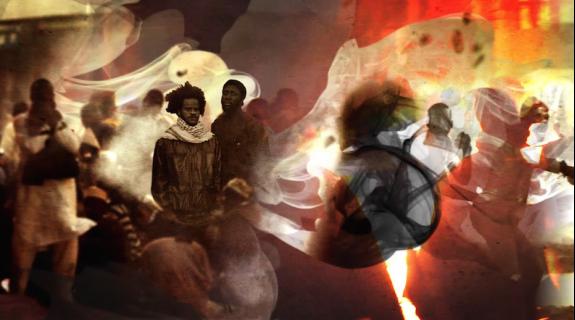Now in its second season, MTV World’s Rebel Music is a documentary series that goes into the heart of conflicted regions of the world to highlight stories of unrepresented youth who are using music and art to drive social change. It’s a potent, even dangerous concept that mandated a similarly stirring look and feel for its graphics package and promotional elements.
Fortunately, MTV World had an ace up its sleeve from the get-go with the design of Rebel Music, thanks to the presence in Season 1 of executive producer Shepard Fairey.
Fairey “was perfect for it because no one understands the art of rebellion better than him,” said Andrew Ross Rowe, supervising producer at MTV World. Still, for Season 2, “we wanted to infuse a lot more authenticity into what we were doing,” he continued. “A lot more grit, a less clean version of our graphics. We wanted it to feel like the rough-and-tumble stories that these musicians are going through.”
For help in designing the next evolution of Rebel Music’s graphics, MTV World partnered with the Studio, a New York digital production company whose own branding happens to be somewhat evocative of protest art.
In particular, the company’s bright red logo, rigidly structured website and bold fonts recalls the geometric designs of the Russian constructivists – who in turn influenced what would become the primary inspiration for Rebel Music’s new graphics package: Latin American political poster art of the ‘60s and ‘70s.
The works that emerged from that period, epitomized today by iconic images of Argentine Marxist revolutionary Che Guevara, have a “universal” appeal,” said Rowe. “Even if you’re not the most informed about the politics of that era and that time, you definitely recognize the aesthetic and I think that is the major drawing point into the series – that you know what’s going on without having to know the history behind it.”
For Mary Nittolo, creative director for the Studio, working on Rebel Music was an opportunity to “express what I love in terms of graphics… I’m a huge fan of Latin American street art. There is a tremendous graphic tradition there and I feel that a lot of street art there really reflects it.”
Working with a logo and schematic pre-established by Fairey was “amazing,” said Nittolo, but the objective for her team was also to take the on-air graphics in another direction.
One approach they took was to dig into a concept in art history known as “pentimenti,” said Nittolo.
“Throughout history thing fade and you start to see the underpinning of what was there before… It’s called ‘pentimenti’ and you have a similar thing when you think of street art. You would have something that was on a wall and then maybe it was painted over, and then there was something else on the wall, and then the wall peels, and then through the peeling wall you see what was there before. It’s what’s showing through from the past images that exist behind what you’re doing… That was very much in my mind while doing this, trying to create that layered feeling.”

The pentimenti approach, said Rowe, helped bring “a lot of the history of the different aspects of the different episodes into our final motion roll. And for our lower thirds you’ll notice more rustic patterns, something that feels like you’re on the ground, it feels like you’re there, and it really goes along with the cinematography that you’re seeing within the episode. It feels a little bit more cinematic, it feels more of a complete package.”
Set to a driving track by Native American musician Frank Waln, the Rebel Music show open epitomizes the harmony between the Studio’s design contributions and the series’ powerful footage. Concept artist Alison Abitbol headed up visuals on the titles, which use sliding panels and a through line of blowing smoke (whose meaning is open to many interesting interpretations) to create momentum and suspense.
“These musicians and these activists are literally risking their lives to do what they do,” said Rowe, “and the objective of the show open was to have a sense of stakes that there’s this urgency that’s happening right now in these other places outside of the U.S.”
In addition to the open and within the episodes, the Studio’s package appears on Rebel Music’s website and in its social media content. Not surprisingly, the show has a thriving global social community and is in some ways more popular online than it is on-air.
When the first episode of Season 1, which focused on youth music in Native American communities, debuted in 2013, it became MTV’s most shared Facebook video ever, and its Facebook page today has nearly 400,000 followers.
In this space, said Dina Madhani, VP of social media and marketing for MTV World, the network could execute the Studio’s graphics at another level, pairing them with static hard-hitting text that “fit into platforms that our audiences really found engaging… We created a lot of great memes with the same imagery and attached really powerful quotes that are universal yet really played into the storyline of what’s happening. So whether you have an interest in the [given episode’s] country or not, you’re all really connected by your humanity.”

CREDITS
Project: “Rebel Music” graphics package
Client: MTV World & Nomadic Wax
Animation: the STUDIO
Creative Director: Mary Nittolo
Executive Producer: Gary Giambalvo
Producer: Kathleen Sobr
3D Artist/CG Lead: Eric Kilanski
Tags:













































__twocolumncontent.jpg)











